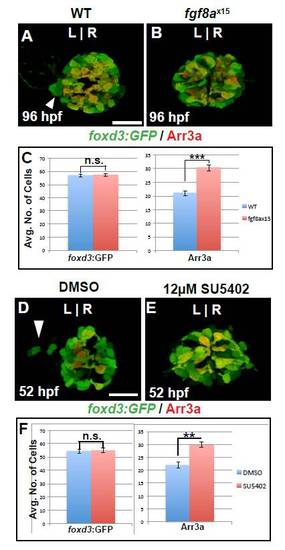Fig. S7
|
Selective increase in cone cells persists in fgf8ax15 mutant and SU5402-treated larvae. (A,B) Dorsal views of WT and fgf8ax15 mutants labeled with foxd3:GFP (pineal complex) and Arr3a (cone photoreceptors) at 96 hpf. fgf8ax15 mutants lack a distinct parapineal organ compared with WT (white arrowhead). (C) Graph quantifying the number of foxd3:GFP- and Arr3a-positive cells in wild-type and fgf8ax15 embryos at 96 hpf. fgf8ax15 and wild-type embryos have equivalent numbers of foxd3:GFP-expressing cells. However, fgf8ax15 mutants have more cone photoreceptors in the pineal complex than are seen in WT. (D,E) Dorsal views of DMSO- and SU5402-treated embryos with parapineal. SU5402-treated embryos lack obvious parapineal (white arrowhead). (F) Graph quantifying the number of Tg[foxd3:GFP] and Arr3a cells in 52 hpf larvae treated with DMSO or 12 μM SU5402 from 24 to 30 hpf. (***P<0.0005 by t-test). Error bars represent s.e.m. n.s., not significant. Scale bar: 25 μm. |

